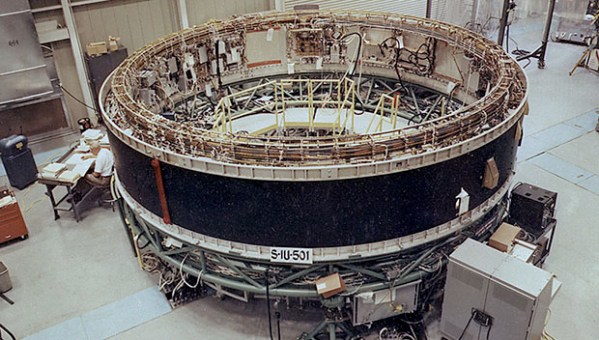It’s been a busy week in space news, and very little of it was good. We’ll start with the one winner of the week, Firefly’s Blue Ghost Mission 1, which landed successfully on the Moon’s surface on March 2. The lander is part of NASA’s Commercial Lunar Payload Services program and carries ten scientific payloads, including a GPS/GNSS receiver that successfully tracked signals from Earth-orbiting satellites. All of the scientific payloads have completed their missions, which is good because the lander isn’t designed to withstand the long, cold lunar night only a few days away. The landing makes Firefly the first commercial outfit to successfully soft-land something on the Moon, and being the first at anything is always a big deal.
saturn v9 Articles
Why The Saturn V Used Kerosene For Its Hydraulics Fluid
We usually think of a hydraulic system as fully self-contained, with a hydraulic pump, tubing, and actuators filled with a working fluid. This of course adds a lot of weight and complexity that can be undesirable in certain projects, with the Saturn V Moon rocket demonstrating a solution to this which is still being used to this day. In a blast-from-the-past, a December 1963 article originally published in Hydraulics & Pneumatics details the kerosene-based hydraulics (fueldraulics) system for the S-1C stage’s gimbal system that controlled the four outer engines.
Rather than a high-pressure, MIL-H-5606 hydraulic oil-based closed loop as in the Saturn I, this takes kerosene from the high-pressure side of the F1 rocket engine’s turbopump and uses it in a single-pass system. This cuts out a separate hydraulic pump, a hydraulic reservoir, which was mostly beneficial in terms of reducing points of failure (and leaks), ergo increasing reliability. Such was the theory at the time at least, and due to issues with RP-1 kerosene’s relatively low flash point and differences in lubricity properties, ultimately RJ-1, RP-1 and MIL-H-5606 were used during checkout leading up to the launch.
In hindsight we know that this fueldraulic system worked as intended with all Saturn V launches, and today it’s still used across a range of aircraft in mostly jet engines and actuators elsewhere of the Boeing 777 as well as the F-35. In the case of the latter it only made the news when there was an issue that grounded these jets due to badly crimped lines. Since fueldraulics tends to be lower pressure, this might be considered a benefit in such cases too, as anyone who has ever experienced a hydraulic line failure can attest to.
Featured image: Gimbal systems proposed for the F-1, oxygen-kerosene engine with a fueldraulic system. (Source: Hydraulics & Pneumatics, 1963)
Hackaday Links: January 31, 2021
There are an awful lot of machines on the market these days that fall under the broad category of “cheap Chinese laser cutters”. You know the type — the K40s, the no-name benchtop CO2 cutters, the bigger floor-mount units. If you’ve recently purchased one of these machines from one of the usual vendors, or even if you’re just thinking about doing so, you’ll likely have some questions. In which case, this “Chinese Laser Cutters 101” online class might be right up your alley. We got wind of this though its organizer, Jonathan Schwartz of American Laser Cutter in Los Angeles, who says he’s been installing, repairing, and using laser cutters for a decade now. The free class will be on February 8 at 5:00 PM PST, and while it’s open to all, it does require registration.
We got an interesting tip the other day that had to do with Benford’s Law. We’d never heard of this one, so we assumed was a “joke law” like Murphy’s Law or Betteridge’s Rule of Headlines. But it turns out that Benford’s Law describes the distribution of leading digits in large sets of numbers. Specifically, it says that the leading digit in any given number is more likely to be one of the smaller numbers. Measurements show that rather than each of the nine base 10 digits showing up about 11% of the time, a 1 will appear in the leading digit 30% of the time, while a 9 will appear about 5% of the time. It’s an interesting phenomenon, and the tip we got pointed to an article that attempted to apply Benford’s Law to image files. This technique was used in a TV show to prove an image had been tampered with, but as it turns out, Hollywood doesn’t always get technical material right. Shocking, we know, but the technique was still interesting and the code developed to Benford-ize image files might be useful in other ways.
Everyone knew it was coming, and for a long time in advance, but it still seems that the once-and-for-all, we’re not kidding this time, it’s for realsies shutdown of Adobe Flash has had some real world consequences. To wit, a railroad system in the northern Chinese city of Dalian ground to a halt earlier this month thanks to Flash going away. No, they weren’t using Flash to control the railroad, but rather it was buried deep inside software used to schedule and route trains. It threw the system into chaos for a while, but never fear — they got back up and running by installing a pirated version of Flash. Here’s hoping that they’re working on a more permanent solution to the problem.
First it was toilet paper and hand sanitizer, now it’s…STM32 chips? Maybe, if the chatter on Twitter and other channels is to be believed. Seems like people are having a hard time sourcing the microcontroller lately. It’s all anecdotal so far, of course, but the prevailing theory is that COVID-19 and worker strikes have lead to a pinch in production. Plus, you know, the whole 2020 thing. We’re wondering if our readers have noticed anything on this — if so, let us know in the comments below.
And finally, just because it’s cool, here’s a video of what rockets would look like if they were transparent. Well, obviously, they’d look like twisted heaps of burning wreckage on the ground is they were really made with clear plastic panels and fuel tanks, but you get the idea. The video launches a virtual fleet — a Saturn V, a Space Shuttle, a Falcon Heavy, and the hypothetical SLS rocket — and flies them in tight formation while we get to watch their consumables be consumed. If the burn rates are accurate, it’s surprising how little fuel and oxidizer the Shuttle used compared to the Saturn. We were also surprised how long the SLS holds onto its escape tower, and were pleased by the Falcon Heavy payload reveal.
Animatronic Saturn V Launch Tower Sends Lego Model To The Moon
When it comes to their more adult-oriented models, Lego really knocked it out of the park with their Saturn V rocket model. Within the constraints of the universe of Lego parts, the one-meter-tall model is incredibly detailed, and thousands of space fans eagerly snapped up the kit when it came out.
But a rocket without a launchpad is just a little sad, which is why [Mark Howe] came up with this animatronic Saturn V launch pad and gantry for his rocket model. The level of detail in the launchpad complements the features of the Saturn V model perfectly, and highlights just what it took to service the crew and the rocket once it was rolled out to the pad. As you can imagine, extensive use of 3D-printed parts was the key to getting the look just right, and to making parts that actually move.
When it’s time for a launch, the sway control arm and hammerhead crane swing out of the way under servo control as the Arduino embedded in the base plays authentic countdown audio. The crew catwalk swings away, the engines light, and the service arms swing back. Then for the pièce de résistance, the Saturn V begins rising slowly from the pad on five columns of flame. [Mark] uses a trio of steppers driving linear actuators to lift the model; the flame effect is cleverly provided by strings of WS2812s inside five clear plastic tubes. We have to say it took some guts to put the precious 1,969-piece model on a lift like that, but the effect was well worth the risk.
This project has a great look and is obviously a labor of love, and a great homage to the Apollo program’s many successes. We’ve got a ton of other Apollo-era hacks on our pages, including a replica DSKY, a rejuvenated AGC, and a look behind the big boards of mission control.
Continue reading “Animatronic Saturn V Launch Tower Sends Lego Model To The Moon”
Russian Rocket Tech Comes In From The Cold
Decades after the end of the space race, an American rocket took off from Cape Canaveral. This was a routine launch to send a communications satellite into orbit, but the situation was an historic first. The rocket in question was driven by a powerful Russian engine unlike any ever built in the States. Although this particular engine was new, the design dated back to the space age.
By the early 1960s, the Russians were leaps and bounds ahead of the United States in terms of space exploration. They had already launched Sputnik and sent Yuri Gagarin to orbit the Earth. All in all, the Russians seemed poised to send a man to the moon. Russian technology had the Americans worried enough to spy on them with satellites, and the images that came back revealed something spectacular. Out in the Kazakh desert, the Russians were building an enormous causeway and two launch pads. As it turns out, the US had every reason to be worried.
Continue reading “Russian Rocket Tech Comes In From The Cold”
Further Teardown Of The Saturn V Flight Computer
[Fran] has been working on tearing down and reverse engineering the Saturn V Launch Vehicle Digital Computer (LVDC). In her finale, she’s succeeded in depotting the legacy components while keeping them intact.
She accomplished this by carefully removing the silicone compound using a gum brush. This was a laborious process, but it allowed her to see the device’s innards. With this knowledge, she could recreate the logic modules on a breadboard.
[Fran]’s work on the LVDC has been very interesting. It began with a look at the PCB, followed by an x-ray analysis. Next up was a three part series of the teardown. With each part is a detailed video on the progress.
While this is the end of [Fran]’s work on the project, she will be handing off the LVDC hardware to another engineer to continue the analysis. We’re looking forward to seeing what comes out of this continued research.
Deconstructing Apollo Flight Hardware
[Fran] has been researching the Saturn V Launch Vehicle Digital Computer – the computer that flew all the Apollo flights into orbit and onwards towards the moon – for a while now. Even though she’s prodded parts of the LVDC with x-rays and multimeters, this is the first time she’s committed to a little destructive testing.
After [Fran] took a flight-ready LVDC spare to the dentist’s office for x-raying and did an amazing amount of research on this artifact from the digital past, there was only so much she could learn without prying apart a few of these small, strange chip packages. Not wanting to destroy her vintage LVDC board, she somehow found another LVDC board for destructive reverse engineering.
This new circuit board was a bit different from the piece in her collection. Instead of the chip leads being soldered, these were welded on, much to the chagrin of [Fran] and her desoldering attempts. After removing one of these chips from the board, she discovered they were potted making any visual inspection a little difficult.
While [Fran]’s attempts at reverse engineering the computer for a Saturn V were a bit unsuccessful, we’ve got to hand it to her for getting this far; it’s very, very likely the tech behind the LVDC was descended from ICBMs and would thus be classified. Documenting the other computer used in every Apollo launch is an impressive feat on its own, and reverse engineering it from actual hardware, well, we can’t think of anything cooler.

















